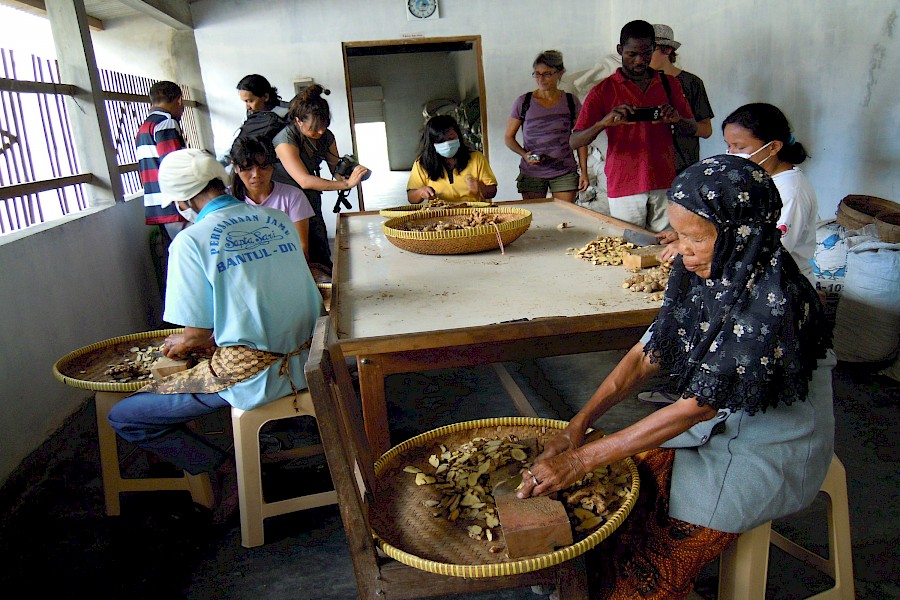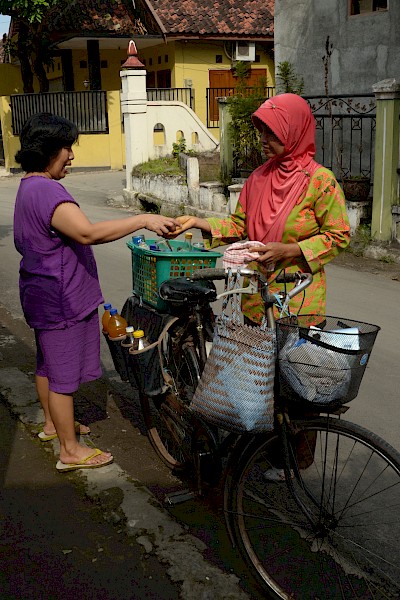Animating anthropology
On doing jamu in Java
—
It is 2013, and we are in the month of Ramadan in Yogyakarta (Jogja) on the island of Java in Indonesia. We are shooting an ethnographic film[note 1] on an ancient art[note 2] of preparing and consuming healing medicines, known as jamu.
click on images to view in ‘slideshow’ mode
Sitting at the foot of Merapi, one of the most active volcanoes on the island, Jogja’s livelihoods are filled with indeterminacies and anxieties. Jamu elixirs are lively compositions of fresh plants, rhizomes, fruits, and spices of all sorts, which both invigorate the body and offer possibilities for unblocking anxieties and treating disease. Unlike modern pharmaceuticals, jamu’s potential efficacies are not reducible to the molecules of the plants each elixir contains. Rather, within a Javanese philosophy that understands the body to be in a fluid and emergent relationship with the surrounding world (Ferzacca 2001), it is the liveliness of plants entangled with the human liveliness of movement required to create the proper combinations of textures, juices, and powders that make the elixirs’ healing potentials very real.
Mostly women prepare these elixirs on a daily basis. The smell of ginger, cardamom, cinnamon, and pepper, mixed with the tangy odours of tamarind and lemon, lingers in the air of the kitchens, markets, spas, and back rooms of jamu cafés where the healing drinks are prepared. In these places, women spend long hours washing rhizomes and leaves under running water, rhythmically crushing spices with large mortars and pestles, and squeezing herbs on a pipisan[note 3]in a slow, back-and-forth motion. Doing jamu is skilful and physically difficult. As the women press boiled curcuma and tamarind with their hands to extract the flesh, they let the juice trickle down through their fingers. The staining of their hands in orange and yellow becomes a testament to the freshness of the elixirs.
The sensorial practice of doing jamu animates, and is animated by, the city and its peripheries. Each day, early in the morning, our film crew meets at the entrance of the home where we are staying, near the Kraton[note 4] in the center of Jogja. The crew includes three Indonesian master’s students in anthropology from Gadjah Mada University, a PhD student in anthropology from the University of Ottawa, a visual artist, my two teenagers, and me. From there, we move through the city in smaller groups, seeking out the multitude of places where jamu is being prepared. As we capture the sounds and movements of the practice of doing jamu with our cameras, phones, and a digital recorder, we also participate in the elixirs’ preparation, smelling, tasting, and touching.
In the streets, dressed in traditional Javanese style, women known as ‘jamu gendong’often carry as many as nine brightly coloured containers of elixirs in a basket tied on their back with a sarong. (The beverage, when carried in this way, is also called jamu gendong.)They usually walk barefoot as they sell jamu door-to-door. More recently, some jamu sellers have begun to travel by bicycles provided by local NGOs, while others are installing semipermanent stalls throughout the city, sometimes incorporating Islamic aesthetics.
While the process of preparing jamu is lengthy, it is consumed rapidly; customers drink it down in a single shot. Situated in a Javanese world that privileges ‘inner feeling’ (rasa), the jamu consumer pursues a particular kind of ‘fit’ (tjotjog): one must take the right jamu in the right way, at the right time, in the right place, from the right seller, and for the right reason. And yet, the phenomenology of consuming jamu privileges multiple possibilities; these lively elixirs unfold, persist, and reverberate. In these ways, doing jamu evokes the image of the rhizome. For Deleuze and Guattari (1980, 31), the rhizome ‘has no beginning and no end, yet always a middle, from which it pushes and overflows’. The practice of doing jamu is both transforming, and is itself continually transformed by the rhythms of everyday life in Jogja. Today, jamu elixirs are historicised in a jamu museum, scrutinized in laboratories, packaged as an ‘instant’ drink powder, featured in botanical gardens, and performed as a part of agrotourism. However, it continues to be the lively fresh drinks, prepared each day by jamu gendong in homes and sold in the streets, that are largely preferred by customers to deal with the uncertainties, anxieties, and indeterminacies of everyday life in the city.
About the author
Julie Laplante is Associate Professor of Anthropology in the School of Sociological and Anthropological Studies at the University of Ottawa. She was a senior research fellow at the Max Planck Institute for Social Anthropology (2006–2010), has published in numerous journals, and is the author of Pouvoir Guérir: Médecines autochtones et humanitaires (Presses Université Laval, 2004) and of Healing Roots: Anthropology in Life and Medicine (Berghahn Books, 2015).
References
Deleuze, Gilles, and Félix Guattari, 1980. Mille Plateaux: Capitalisme et schizophrénie. Paris: Éditions de Minuit.
Ferzacca, Steve. 2001. Healing the Modern in a Central Javanese City. Durham, NC: Carolina Academic Press.
Endnotes
1 Back
Jamu Stories (2015) https://www.youtube.com/watch?v=CMRZRw1z2Fw
2 Back
In Java, traces of this practice are found as far back as the eighth century in the Hindu Temple of Prambanan near Jogja.
3 Back
A cylindre-shaped stone and stone tablet, between which herbs are rolled in order to extract juices.
4 Back
The Kraton or ‘Palace’ is a walled city within Jodja, and home to around twenty-five thousand people.









